Comprehensive Report: Information Systems, ERP, and Business Processes
VerifiedAdded on 2021/01/01
|16
|2539
|452
Report
AI Summary
This report provides a comprehensive overview of information systems and their applications in business development. It begins by defining information systems and their role in transforming raw data into useful information for decision-making. The report then categorizes different types of information systems, including Transaction Processing Systems (TPS), Management Information Systems (MIS), Decision Support Systems (DSS), and Executive Information Systems (EIS), detailing their functions and applications within an organization. Furthermore, the report focuses on Enterprise Resource Planning (ERP) systems, describing their modular structure, core components, and benefits, such as streamlining processes, improving efficiency, and facilitating better decision-making. Real-life business examples and advantages and disadvantages of ERP systems are also discussed. The report concludes with recommendations for organizations on how to effectively implement and utilize information technology to enhance business performance, including training, customization, and customer feedback.
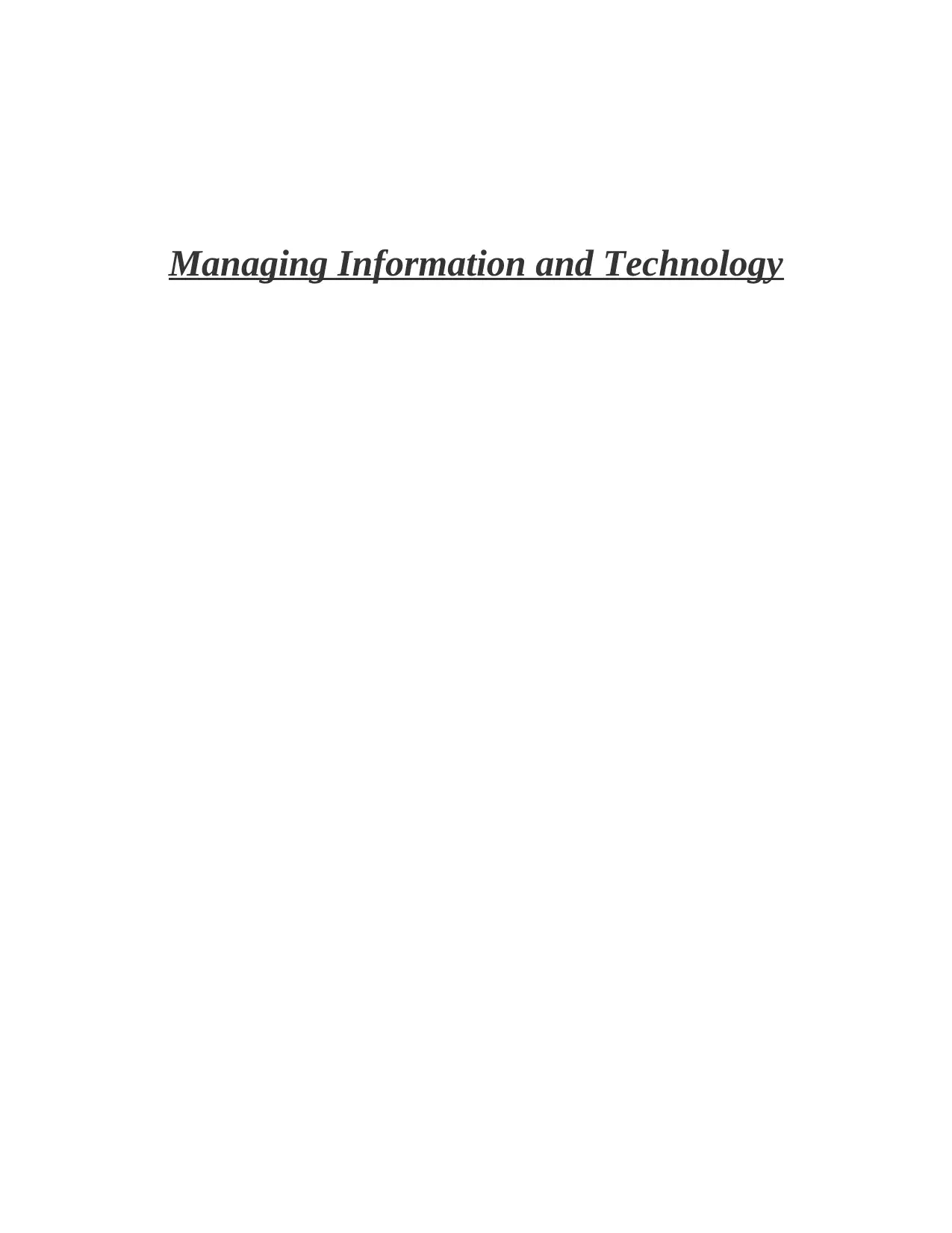
Managing Information and Technology
Paraphrase This Document
Need a fresh take? Get an instant paraphrase of this document with our AI Paraphraser
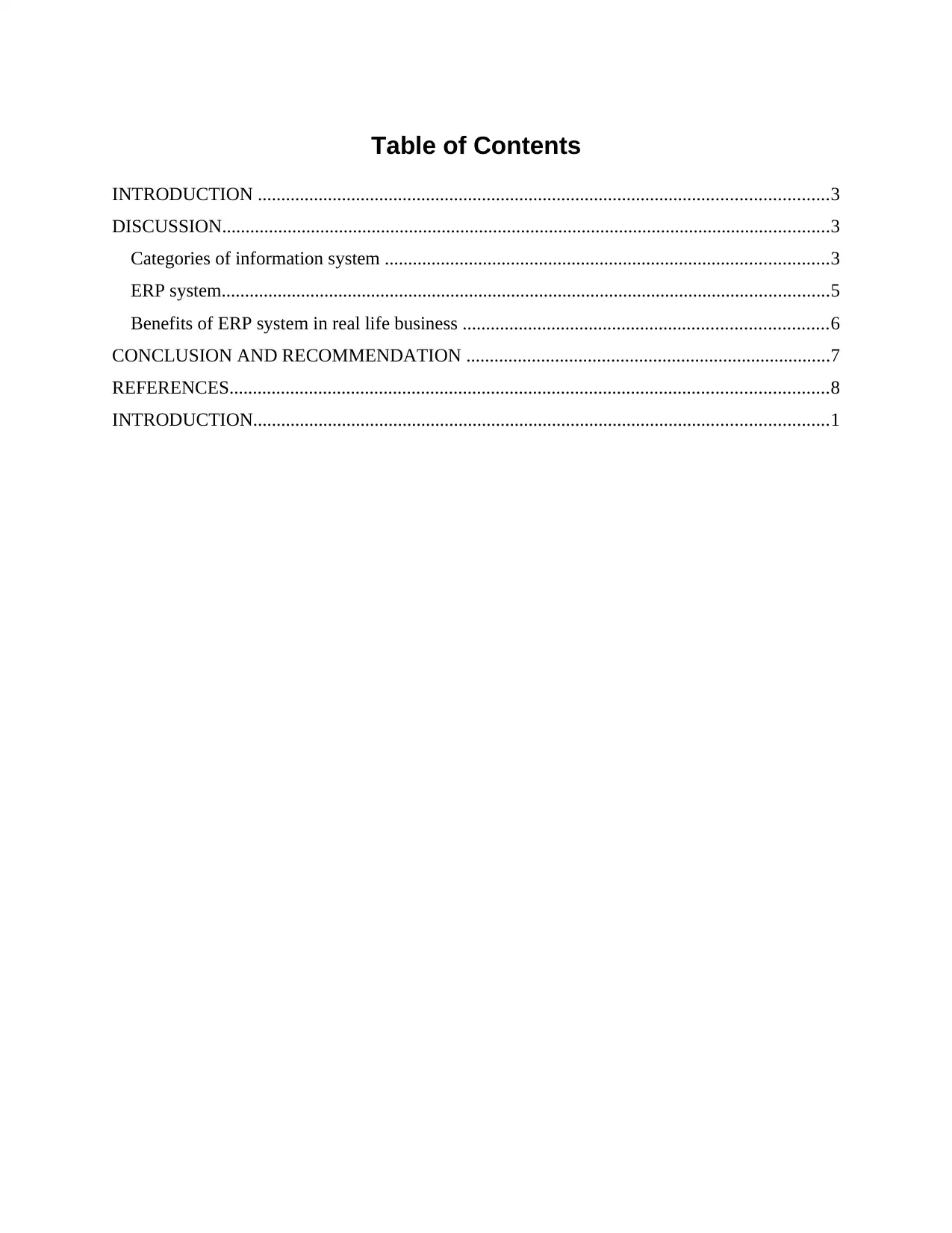
Table of Contents
INTRODUCTION ..........................................................................................................................3
DISCUSSION..................................................................................................................................3
Categories of information system ...............................................................................................3
ERP system..................................................................................................................................5
Benefits of ERP system in real life business ..............................................................................6
CONCLUSION AND RECOMMENDATION ..............................................................................7
REFERENCES................................................................................................................................8
INTRODUCTION...........................................................................................................................1
INTRODUCTION ..........................................................................................................................3
DISCUSSION..................................................................................................................................3
Categories of information system ...............................................................................................3
ERP system..................................................................................................................................5
Benefits of ERP system in real life business ..............................................................................6
CONCLUSION AND RECOMMENDATION ..............................................................................7
REFERENCES................................................................................................................................8
INTRODUCTION...........................................................................................................................1
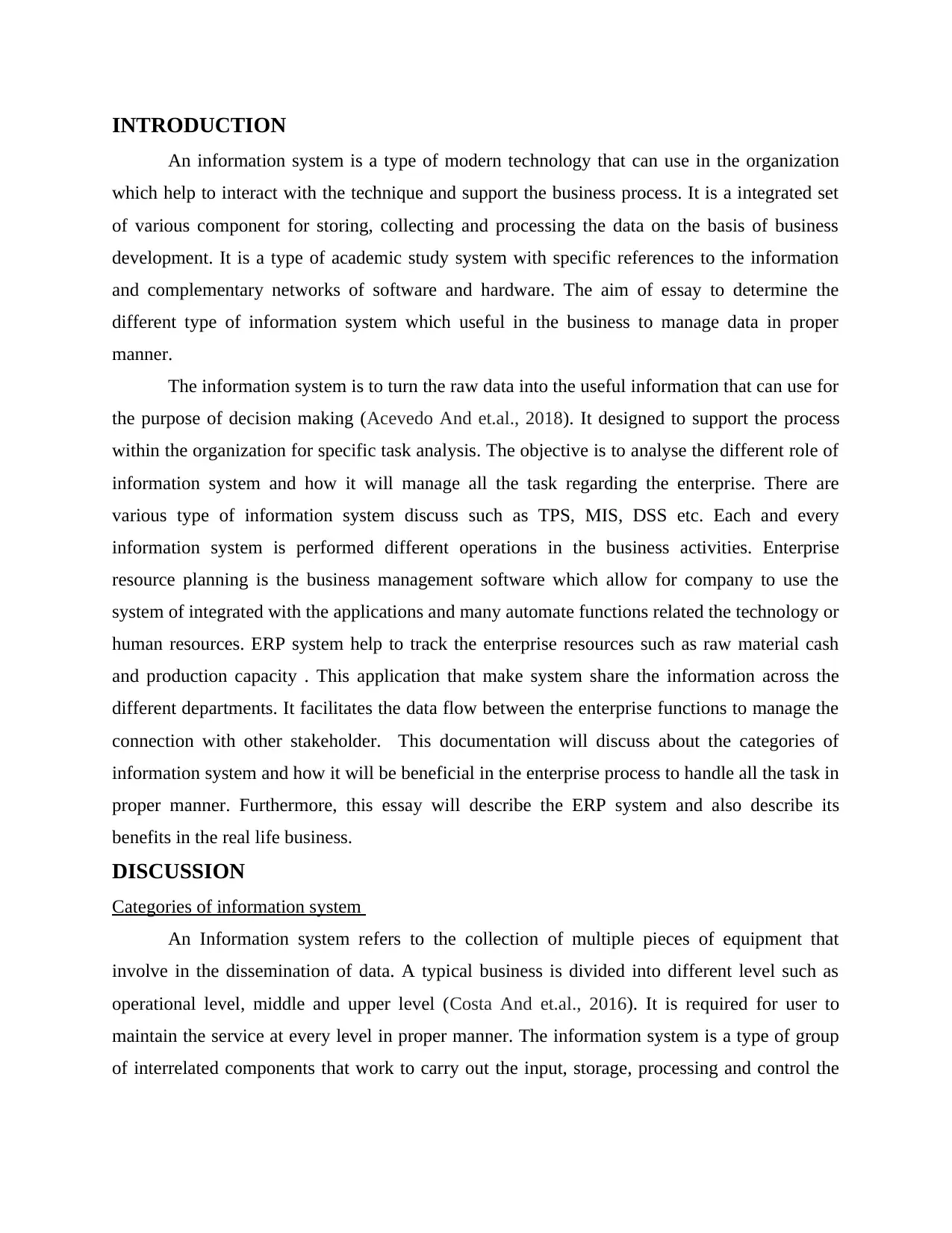
INTRODUCTION
An information system is a type of modern technology that can use in the organization
which help to interact with the technique and support the business process. It is a integrated set
of various component for storing, collecting and processing the data on the basis of business
development. It is a type of academic study system with specific references to the information
and complementary networks of software and hardware. The aim of essay to determine the
different type of information system which useful in the business to manage data in proper
manner.
The information system is to turn the raw data into the useful information that can use for
the purpose of decision making (Acevedo And et.al., 2018). It designed to support the process
within the organization for specific task analysis. The objective is to analyse the different role of
information system and how it will manage all the task regarding the enterprise. There are
various type of information system discuss such as TPS, MIS, DSS etc. Each and every
information system is performed different operations in the business activities. Enterprise
resource planning is the business management software which allow for company to use the
system of integrated with the applications and many automate functions related the technology or
human resources. ERP system help to track the enterprise resources such as raw material cash
and production capacity . This application that make system share the information across the
different departments. It facilitates the data flow between the enterprise functions to manage the
connection with other stakeholder. This documentation will discuss about the categories of
information system and how it will be beneficial in the enterprise process to handle all the task in
proper manner. Furthermore, this essay will describe the ERP system and also describe its
benefits in the real life business.
DISCUSSION
Categories of information system
An Information system refers to the collection of multiple pieces of equipment that
involve in the dissemination of data. A typical business is divided into different level such as
operational level, middle and upper level (Costa And et.al., 2016). It is required for user to
maintain the service at every level in proper manner. The information system is a type of group
of interrelated components that work to carry out the input, storage, processing and control the
An information system is a type of modern technology that can use in the organization
which help to interact with the technique and support the business process. It is a integrated set
of various component for storing, collecting and processing the data on the basis of business
development. It is a type of academic study system with specific references to the information
and complementary networks of software and hardware. The aim of essay to determine the
different type of information system which useful in the business to manage data in proper
manner.
The information system is to turn the raw data into the useful information that can use for
the purpose of decision making (Acevedo And et.al., 2018). It designed to support the process
within the organization for specific task analysis. The objective is to analyse the different role of
information system and how it will manage all the task regarding the enterprise. There are
various type of information system discuss such as TPS, MIS, DSS etc. Each and every
information system is performed different operations in the business activities. Enterprise
resource planning is the business management software which allow for company to use the
system of integrated with the applications and many automate functions related the technology or
human resources. ERP system help to track the enterprise resources such as raw material cash
and production capacity . This application that make system share the information across the
different departments. It facilitates the data flow between the enterprise functions to manage the
connection with other stakeholder. This documentation will discuss about the categories of
information system and how it will be beneficial in the enterprise process to handle all the task in
proper manner. Furthermore, this essay will describe the ERP system and also describe its
benefits in the real life business.
DISCUSSION
Categories of information system
An Information system refers to the collection of multiple pieces of equipment that
involve in the dissemination of data. A typical business is divided into different level such as
operational level, middle and upper level (Costa And et.al., 2016). It is required for user to
maintain the service at every level in proper manner. The information system is a type of group
of interrelated components that work to carry out the input, storage, processing and control the
⊘ This is a preview!⊘
Do you want full access?
Subscribe today to unlock all pages.

Trusted by 1+ million students worldwide
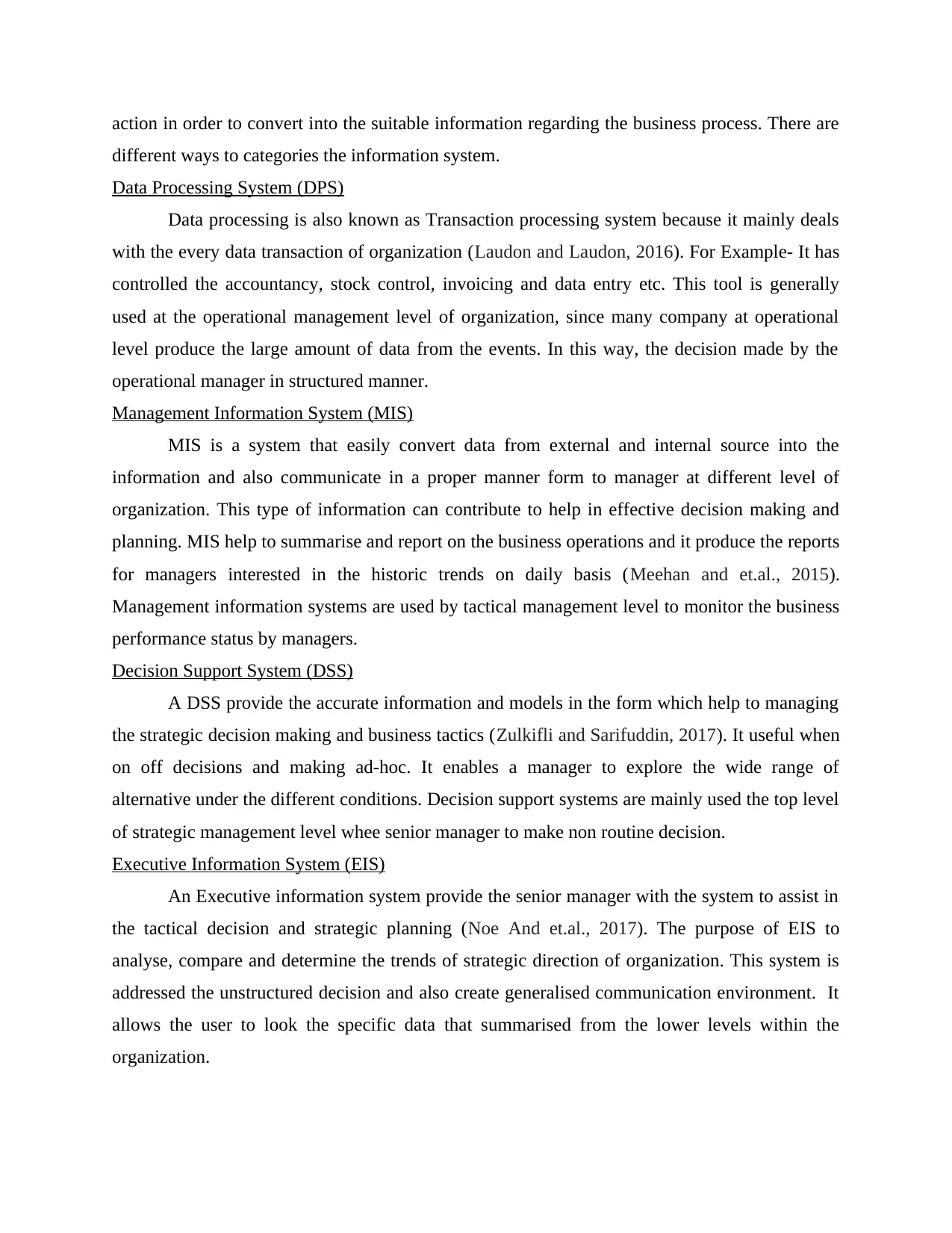
action in order to convert into the suitable information regarding the business process. There are
different ways to categories the information system.
Data Processing System (DPS)
Data processing is also known as Transaction processing system because it mainly deals
with the every data transaction of organization (Laudon and Laudon, 2016). For Example- It has
controlled the accountancy, stock control, invoicing and data entry etc. This tool is generally
used at the operational management level of organization, since many company at operational
level produce the large amount of data from the events. In this way, the decision made by the
operational manager in structured manner.
Management Information System (MIS)
MIS is a system that easily convert data from external and internal source into the
information and also communicate in a proper manner form to manager at different level of
organization. This type of information can contribute to help in effective decision making and
planning. MIS help to summarise and report on the business operations and it produce the reports
for managers interested in the historic trends on daily basis (Meehan and et.al., 2015).
Management information systems are used by tactical management level to monitor the business
performance status by managers.
Decision Support System (DSS)
A DSS provide the accurate information and models in the form which help to managing
the strategic decision making and business tactics (Zulkifli and Sarifuddin, 2017). It useful when
on off decisions and making ad-hoc. It enables a manager to explore the wide range of
alternative under the different conditions. Decision support systems are mainly used the top level
of strategic management level whee senior manager to make non routine decision.
Executive Information System (EIS)
An Executive information system provide the senior manager with the system to assist in
the tactical decision and strategic planning (Noe And et.al., 2017). The purpose of EIS to
analyse, compare and determine the trends of strategic direction of organization. This system is
addressed the unstructured decision and also create generalised communication environment. It
allows the user to look the specific data that summarised from the lower levels within the
organization.
different ways to categories the information system.
Data Processing System (DPS)
Data processing is also known as Transaction processing system because it mainly deals
with the every data transaction of organization (Laudon and Laudon, 2016). For Example- It has
controlled the accountancy, stock control, invoicing and data entry etc. This tool is generally
used at the operational management level of organization, since many company at operational
level produce the large amount of data from the events. In this way, the decision made by the
operational manager in structured manner.
Management Information System (MIS)
MIS is a system that easily convert data from external and internal source into the
information and also communicate in a proper manner form to manager at different level of
organization. This type of information can contribute to help in effective decision making and
planning. MIS help to summarise and report on the business operations and it produce the reports
for managers interested in the historic trends on daily basis (Meehan and et.al., 2015).
Management information systems are used by tactical management level to monitor the business
performance status by managers.
Decision Support System (DSS)
A DSS provide the accurate information and models in the form which help to managing
the strategic decision making and business tactics (Zulkifli and Sarifuddin, 2017). It useful when
on off decisions and making ad-hoc. It enables a manager to explore the wide range of
alternative under the different conditions. Decision support systems are mainly used the top level
of strategic management level whee senior manager to make non routine decision.
Executive Information System (EIS)
An Executive information system provide the senior manager with the system to assist in
the tactical decision and strategic planning (Noe And et.al., 2017). The purpose of EIS to
analyse, compare and determine the trends of strategic direction of organization. This system is
addressed the unstructured decision and also create generalised communication environment. It
allows the user to look the specific data that summarised from the lower levels within the
organization.
Paraphrase This Document
Need a fresh take? Get an instant paraphrase of this document with our AI Paraphraser
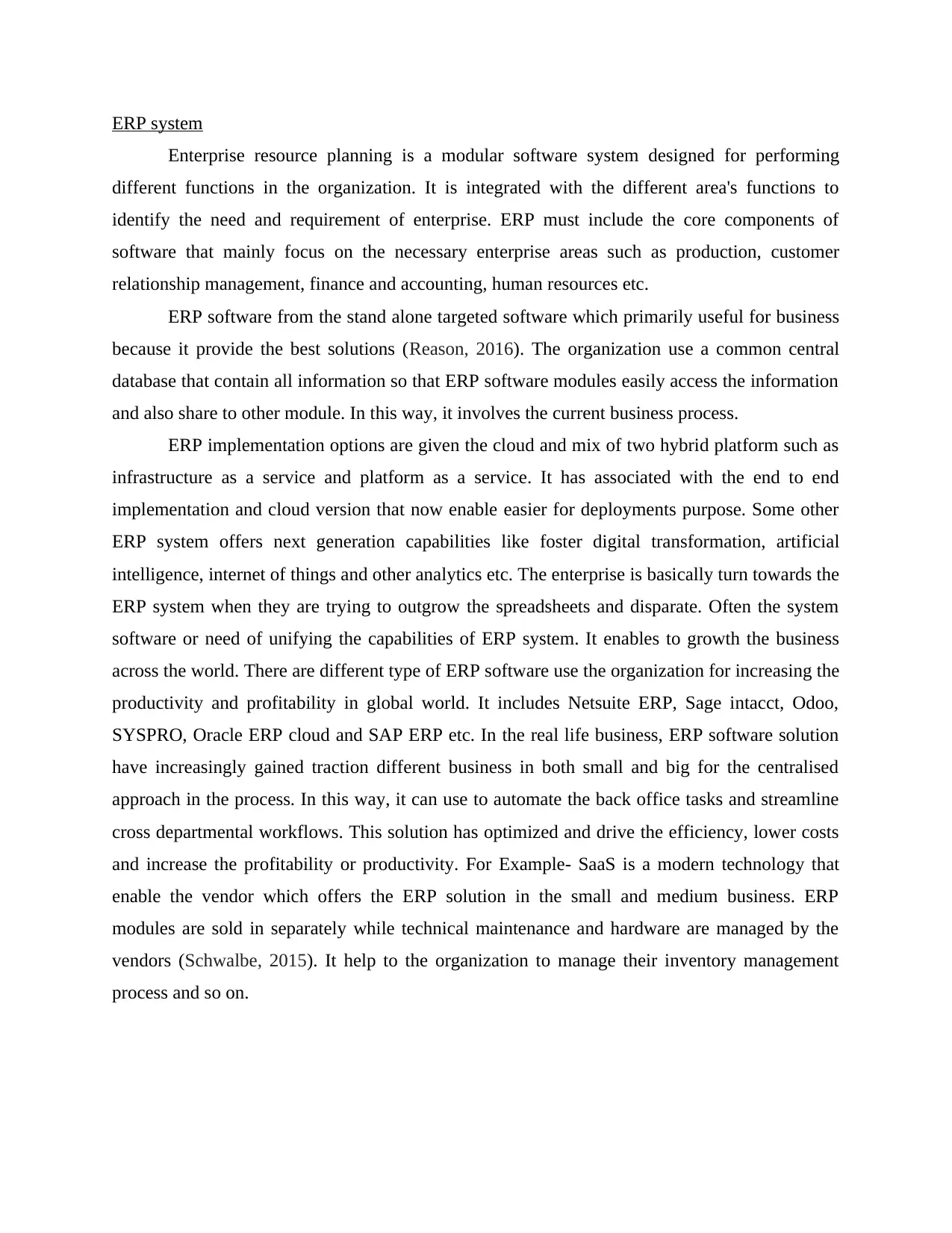
ERP system
Enterprise resource planning is a modular software system designed for performing
different functions in the organization. It is integrated with the different area's functions to
identify the need and requirement of enterprise. ERP must include the core components of
software that mainly focus on the necessary enterprise areas such as production, customer
relationship management, finance and accounting, human resources etc.
ERP software from the stand alone targeted software which primarily useful for business
because it provide the best solutions (Reason, 2016). The organization use a common central
database that contain all information so that ERP software modules easily access the information
and also share to other module. In this way, it involves the current business process.
ERP implementation options are given the cloud and mix of two hybrid platform such as
infrastructure as a service and platform as a service. It has associated with the end to end
implementation and cloud version that now enable easier for deployments purpose. Some other
ERP system offers next generation capabilities like foster digital transformation, artificial
intelligence, internet of things and other analytics etc. The enterprise is basically turn towards the
ERP system when they are trying to outgrow the spreadsheets and disparate. Often the system
software or need of unifying the capabilities of ERP system. It enables to growth the business
across the world. There are different type of ERP software use the organization for increasing the
productivity and profitability in global world. It includes Netsuite ERP, Sage intacct, Odoo,
SYSPRO, Oracle ERP cloud and SAP ERP etc. In the real life business, ERP software solution
have increasingly gained traction different business in both small and big for the centralised
approach in the process. In this way, it can use to automate the back office tasks and streamline
cross departmental workflows. This solution has optimized and drive the efficiency, lower costs
and increase the profitability or productivity. For Example- SaaS is a modern technology that
enable the vendor which offers the ERP solution in the small and medium business. ERP
modules are sold in separately while technical maintenance and hardware are managed by the
vendors (Schwalbe, 2015). It help to the organization to manage their inventory management
process and so on.
Enterprise resource planning is a modular software system designed for performing
different functions in the organization. It is integrated with the different area's functions to
identify the need and requirement of enterprise. ERP must include the core components of
software that mainly focus on the necessary enterprise areas such as production, customer
relationship management, finance and accounting, human resources etc.
ERP software from the stand alone targeted software which primarily useful for business
because it provide the best solutions (Reason, 2016). The organization use a common central
database that contain all information so that ERP software modules easily access the information
and also share to other module. In this way, it involves the current business process.
ERP implementation options are given the cloud and mix of two hybrid platform such as
infrastructure as a service and platform as a service. It has associated with the end to end
implementation and cloud version that now enable easier for deployments purpose. Some other
ERP system offers next generation capabilities like foster digital transformation, artificial
intelligence, internet of things and other analytics etc. The enterprise is basically turn towards the
ERP system when they are trying to outgrow the spreadsheets and disparate. Often the system
software or need of unifying the capabilities of ERP system. It enables to growth the business
across the world. There are different type of ERP software use the organization for increasing the
productivity and profitability in global world. It includes Netsuite ERP, Sage intacct, Odoo,
SYSPRO, Oracle ERP cloud and SAP ERP etc. In the real life business, ERP software solution
have increasingly gained traction different business in both small and big for the centralised
approach in the process. In this way, it can use to automate the back office tasks and streamline
cross departmental workflows. This solution has optimized and drive the efficiency, lower costs
and increase the profitability or productivity. For Example- SaaS is a modern technology that
enable the vendor which offers the ERP solution in the small and medium business. ERP
modules are sold in separately while technical maintenance and hardware are managed by the
vendors (Schwalbe, 2015). It help to the organization to manage their inventory management
process and so on.
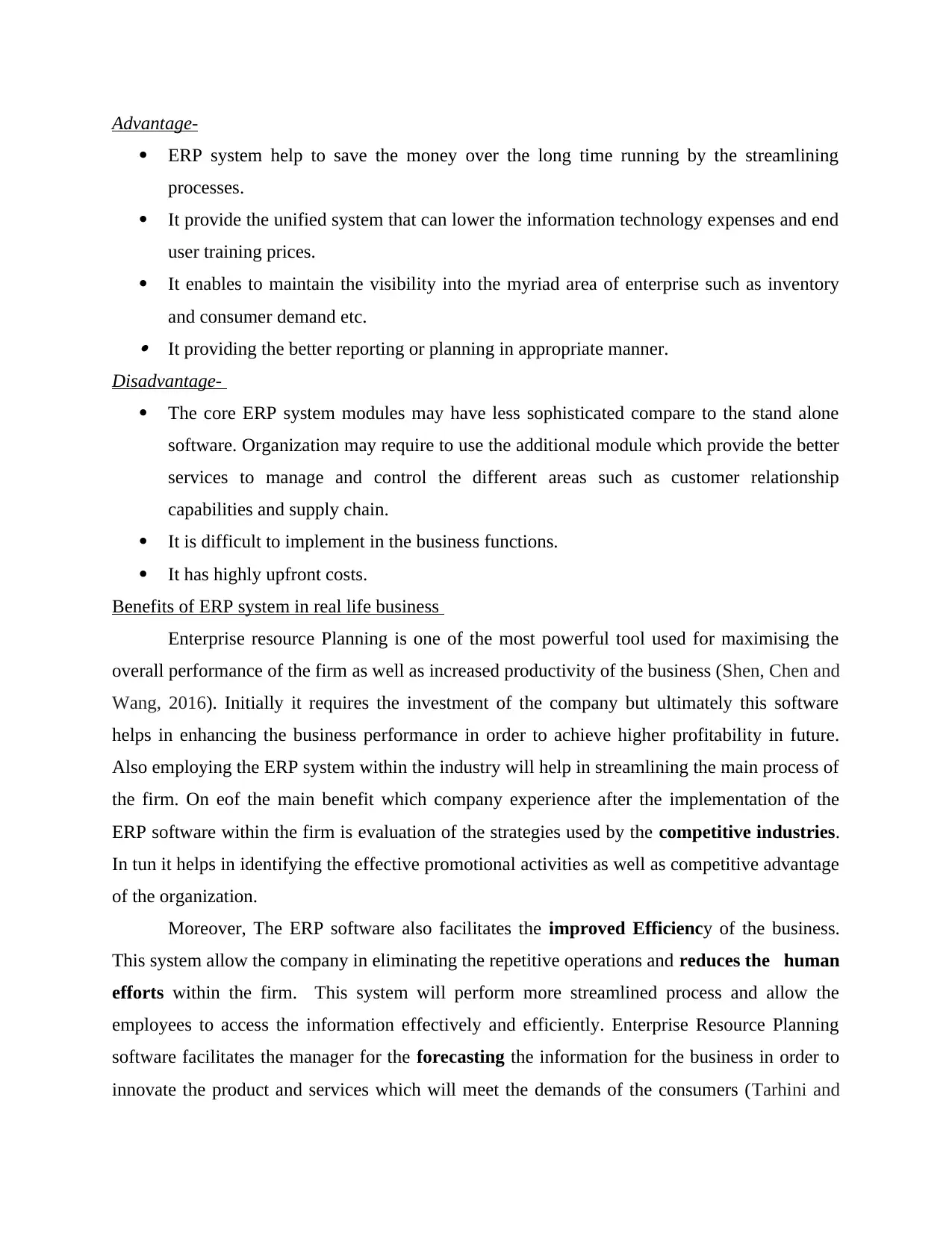
Advantage-
ERP system help to save the money over the long time running by the streamlining
processes.
It provide the unified system that can lower the information technology expenses and end
user training prices.
It enables to maintain the visibility into the myriad area of enterprise such as inventory
and consumer demand etc. It providing the better reporting or planning in appropriate manner.
Disadvantage-
The core ERP system modules may have less sophisticated compare to the stand alone
software. Organization may require to use the additional module which provide the better
services to manage and control the different areas such as customer relationship
capabilities and supply chain.
It is difficult to implement in the business functions.
It has highly upfront costs.
Benefits of ERP system in real life business
Enterprise resource Planning is one of the most powerful tool used for maximising the
overall performance of the firm as well as increased productivity of the business (Shen, Chen and
Wang, 2016). Initially it requires the investment of the company but ultimately this software
helps in enhancing the business performance in order to achieve higher profitability in future.
Also employing the ERP system within the industry will help in streamlining the main process of
the firm. On eof the main benefit which company experience after the implementation of the
ERP software within the firm is evaluation of the strategies used by the competitive industries.
In tun it helps in identifying the effective promotional activities as well as competitive advantage
of the organization.
Moreover, The ERP software also facilitates the improved Efficiency of the business.
This system allow the company in eliminating the repetitive operations and reduces the human
efforts within the firm. This system will perform more streamlined process and allow the
employees to access the information effectively and efficiently. Enterprise Resource Planning
software facilitates the manager for the forecasting the information for the business in order to
innovate the product and services which will meet the demands of the consumers (Tarhini and
ERP system help to save the money over the long time running by the streamlining
processes.
It provide the unified system that can lower the information technology expenses and end
user training prices.
It enables to maintain the visibility into the myriad area of enterprise such as inventory
and consumer demand etc. It providing the better reporting or planning in appropriate manner.
Disadvantage-
The core ERP system modules may have less sophisticated compare to the stand alone
software. Organization may require to use the additional module which provide the better
services to manage and control the different areas such as customer relationship
capabilities and supply chain.
It is difficult to implement in the business functions.
It has highly upfront costs.
Benefits of ERP system in real life business
Enterprise resource Planning is one of the most powerful tool used for maximising the
overall performance of the firm as well as increased productivity of the business (Shen, Chen and
Wang, 2016). Initially it requires the investment of the company but ultimately this software
helps in enhancing the business performance in order to achieve higher profitability in future.
Also employing the ERP system within the industry will help in streamlining the main process of
the firm. On eof the main benefit which company experience after the implementation of the
ERP software within the firm is evaluation of the strategies used by the competitive industries.
In tun it helps in identifying the effective promotional activities as well as competitive advantage
of the organization.
Moreover, The ERP software also facilitates the improved Efficiency of the business.
This system allow the company in eliminating the repetitive operations and reduces the human
efforts within the firm. This system will perform more streamlined process and allow the
employees to access the information effectively and efficiently. Enterprise Resource Planning
software facilitates the manager for the forecasting the information for the business in order to
innovate the product and services which will meet the demands of the consumers (Tarhini and
⊘ This is a preview!⊘
Do you want full access?
Subscribe today to unlock all pages.

Trusted by 1+ million students worldwide
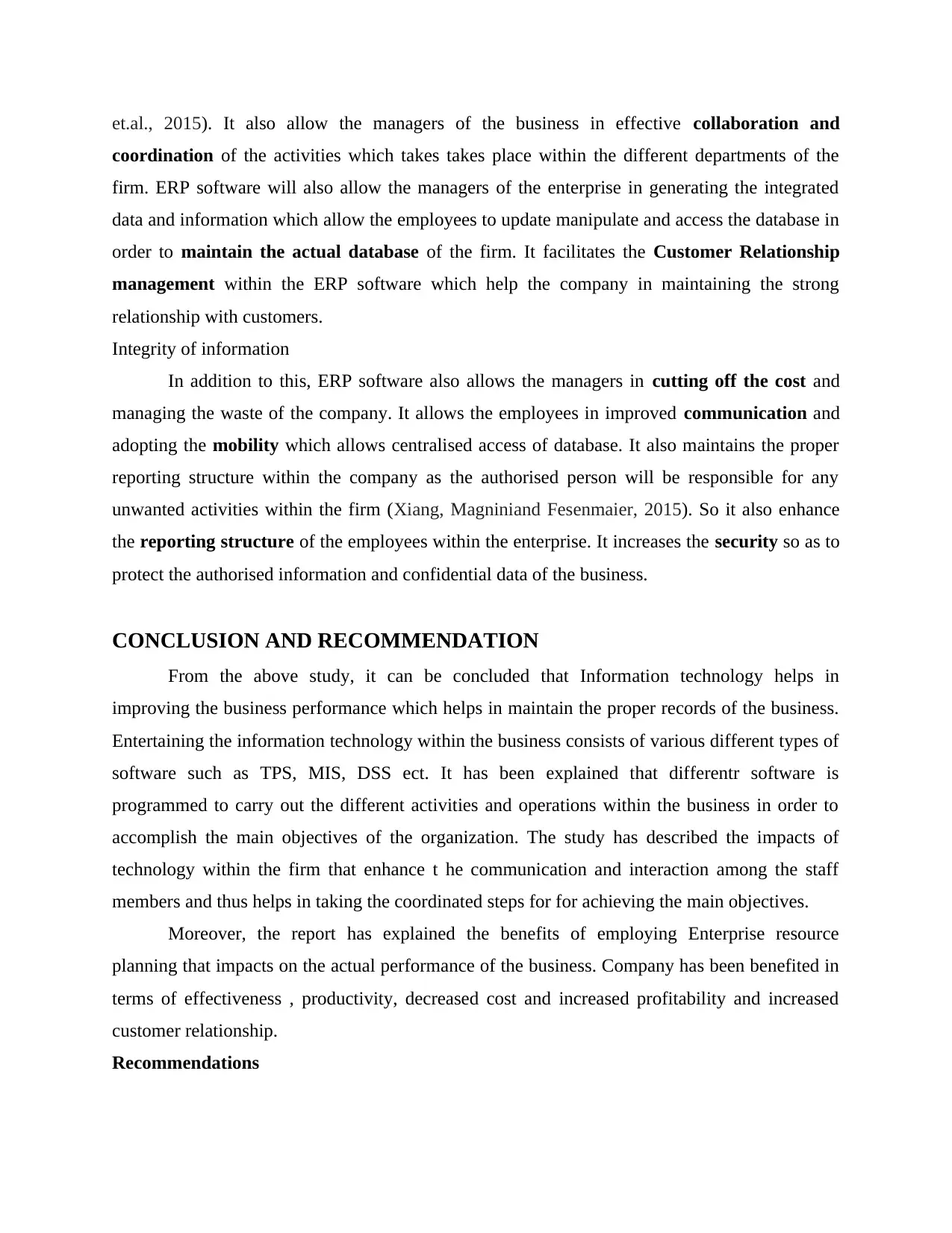
et.al., 2015). It also allow the managers of the business in effective collaboration and
coordination of the activities which takes takes place within the different departments of the
firm. ERP software will also allow the managers of the enterprise in generating the integrated
data and information which allow the employees to update manipulate and access the database in
order to maintain the actual database of the firm. It facilitates the Customer Relationship
management within the ERP software which help the company in maintaining the strong
relationship with customers.
Integrity of information
In addition to this, ERP software also allows the managers in cutting off the cost and
managing the waste of the company. It allows the employees in improved communication and
adopting the mobility which allows centralised access of database. It also maintains the proper
reporting structure within the company as the authorised person will be responsible for any
unwanted activities within the firm (Xiang, Magniniand Fesenmaier, 2015). So it also enhance
the reporting structure of the employees within the enterprise. It increases the security so as to
protect the authorised information and confidential data of the business.
CONCLUSION AND RECOMMENDATION
From the above study, it can be concluded that Information technology helps in
improving the business performance which helps in maintain the proper records of the business.
Entertaining the information technology within the business consists of various different types of
software such as TPS, MIS, DSS ect. It has been explained that differentr software is
programmed to carry out the different activities and operations within the business in order to
accomplish the main objectives of the organization. The study has described the impacts of
technology within the firm that enhance t he communication and interaction among the staff
members and thus helps in taking the coordinated steps for for achieving the main objectives.
Moreover, the report has explained the benefits of employing Enterprise resource
planning that impacts on the actual performance of the business. Company has been benefited in
terms of effectiveness , productivity, decreased cost and increased profitability and increased
customer relationship.
Recommendations
coordination of the activities which takes takes place within the different departments of the
firm. ERP software will also allow the managers of the enterprise in generating the integrated
data and information which allow the employees to update manipulate and access the database in
order to maintain the actual database of the firm. It facilitates the Customer Relationship
management within the ERP software which help the company in maintaining the strong
relationship with customers.
Integrity of information
In addition to this, ERP software also allows the managers in cutting off the cost and
managing the waste of the company. It allows the employees in improved communication and
adopting the mobility which allows centralised access of database. It also maintains the proper
reporting structure within the company as the authorised person will be responsible for any
unwanted activities within the firm (Xiang, Magniniand Fesenmaier, 2015). So it also enhance
the reporting structure of the employees within the enterprise. It increases the security so as to
protect the authorised information and confidential data of the business.
CONCLUSION AND RECOMMENDATION
From the above study, it can be concluded that Information technology helps in
improving the business performance which helps in maintain the proper records of the business.
Entertaining the information technology within the business consists of various different types of
software such as TPS, MIS, DSS ect. It has been explained that differentr software is
programmed to carry out the different activities and operations within the business in order to
accomplish the main objectives of the organization. The study has described the impacts of
technology within the firm that enhance t he communication and interaction among the staff
members and thus helps in taking the coordinated steps for for achieving the main objectives.
Moreover, the report has explained the benefits of employing Enterprise resource
planning that impacts on the actual performance of the business. Company has been benefited in
terms of effectiveness , productivity, decreased cost and increased profitability and increased
customer relationship.
Recommendations
Paraphrase This Document
Need a fresh take? Get an instant paraphrase of this document with our AI Paraphraser
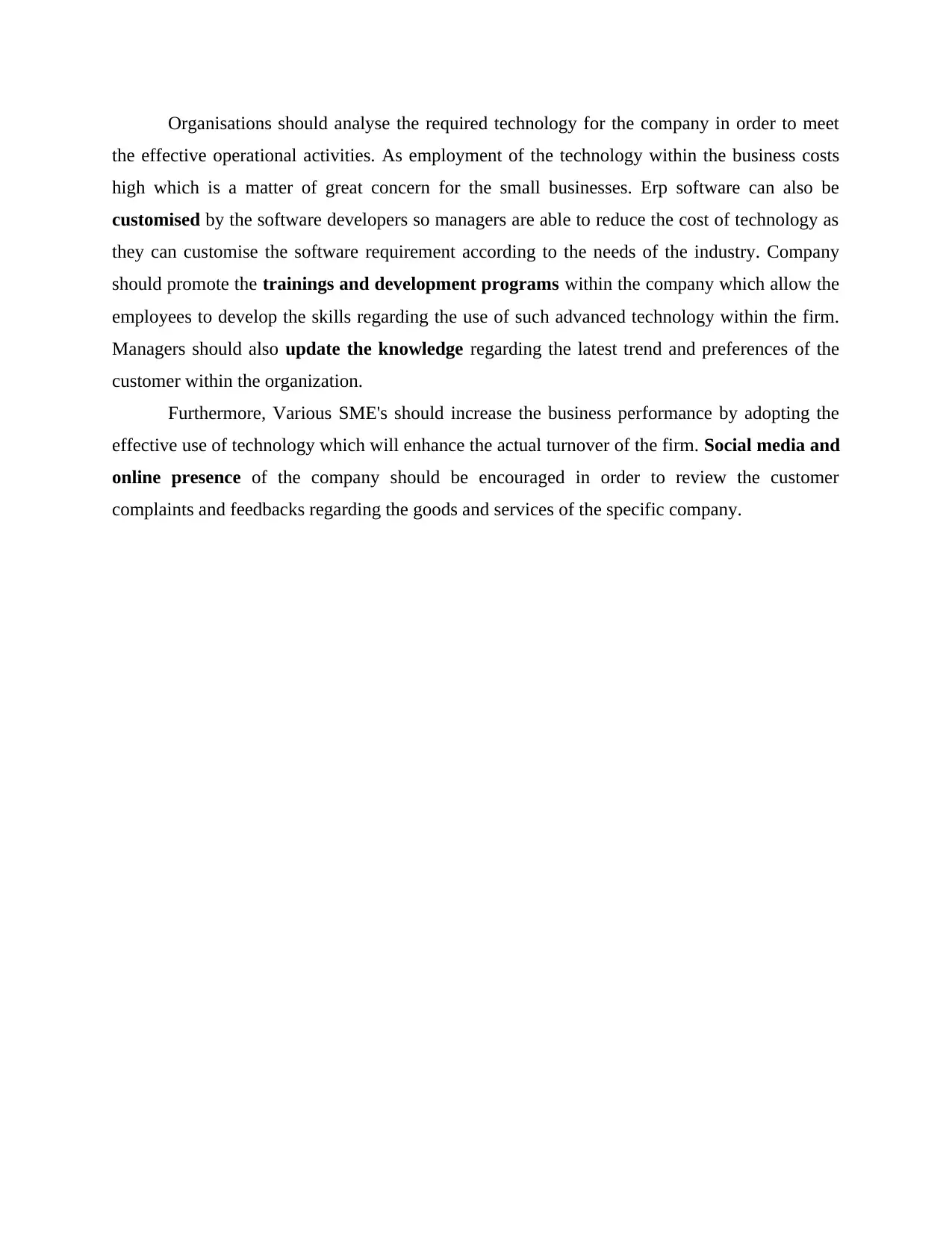
Organisations should analyse the required technology for the company in order to meet
the effective operational activities. As employment of the technology within the business costs
high which is a matter of great concern for the small businesses. Erp software can also be
customised by the software developers so managers are able to reduce the cost of technology as
they can customise the software requirement according to the needs of the industry. Company
should promote the trainings and development programs within the company which allow the
employees to develop the skills regarding the use of such advanced technology within the firm.
Managers should also update the knowledge regarding the latest trend and preferences of the
customer within the organization.
Furthermore, Various SME's should increase the business performance by adopting the
effective use of technology which will enhance the actual turnover of the firm. Social media and
online presence of the company should be encouraged in order to review the customer
complaints and feedbacks regarding the goods and services of the specific company.
the effective operational activities. As employment of the technology within the business costs
high which is a matter of great concern for the small businesses. Erp software can also be
customised by the software developers so managers are able to reduce the cost of technology as
they can customise the software requirement according to the needs of the industry. Company
should promote the trainings and development programs within the company which allow the
employees to develop the skills regarding the use of such advanced technology within the firm.
Managers should also update the knowledge regarding the latest trend and preferences of the
customer within the organization.
Furthermore, Various SME's should increase the business performance by adopting the
effective use of technology which will enhance the actual turnover of the firm. Social media and
online presence of the company should be encouraged in order to review the customer
complaints and feedbacks regarding the goods and services of the specific company.
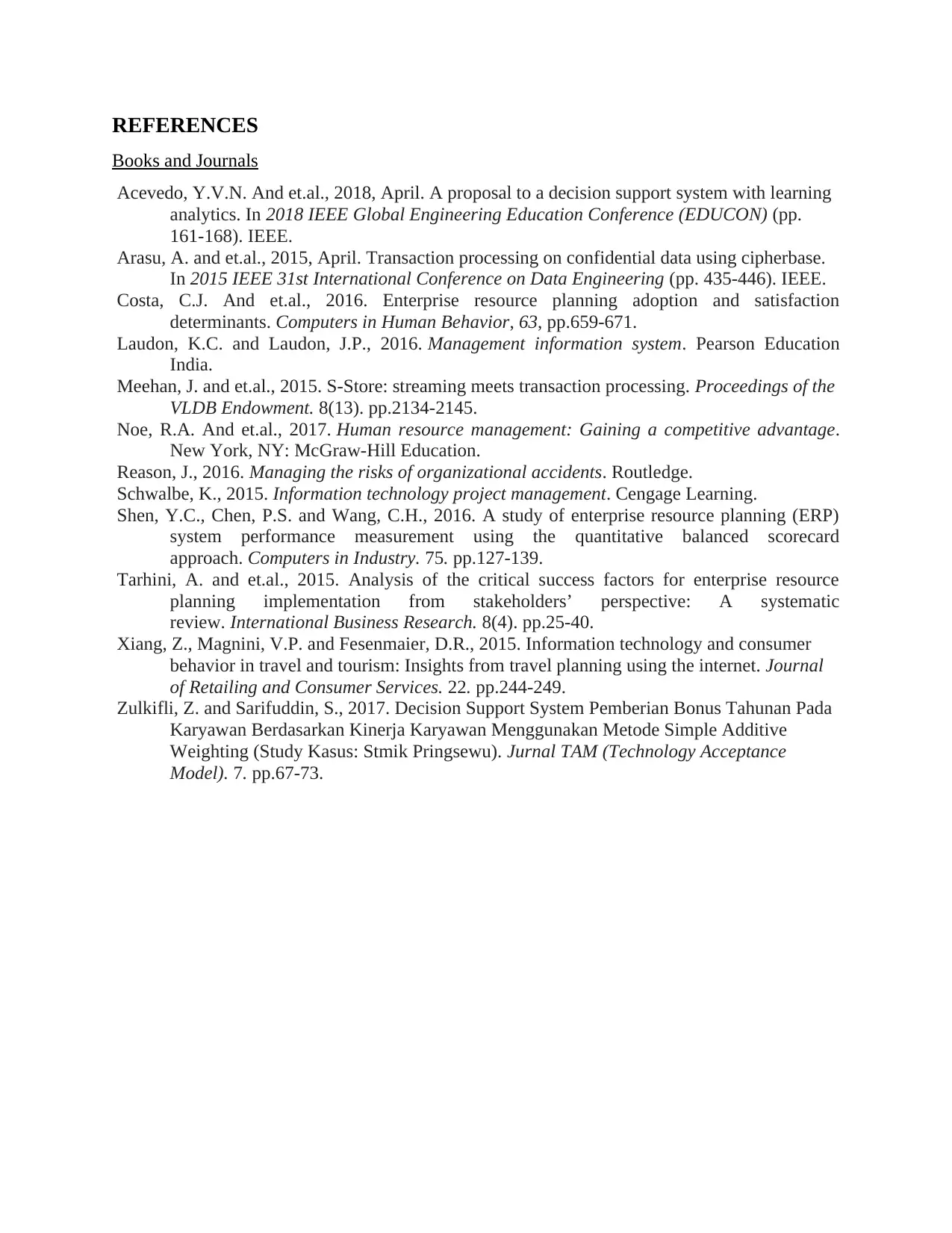
REFERENCES
Books and Journals
Acevedo, Y.V.N. And et.al., 2018, April. A proposal to a decision support system with learning
analytics. In 2018 IEEE Global Engineering Education Conference (EDUCON) (pp.
161-168). IEEE.
Arasu, A. and et.al., 2015, April. Transaction processing on confidential data using cipherbase.
In 2015 IEEE 31st International Conference on Data Engineering (pp. 435-446). IEEE.
Costa, C.J. And et.al., 2016. Enterprise resource planning adoption and satisfaction
determinants. Computers in Human Behavior, 63, pp.659-671.
Laudon, K.C. and Laudon, J.P., 2016. Management information system. Pearson Education
India.
Meehan, J. and et.al., 2015. S-Store: streaming meets transaction processing. Proceedings of the
VLDB Endowment. 8(13). pp.2134-2145.
Noe, R.A. And et.al., 2017. Human resource management: Gaining a competitive advantage.
New York, NY: McGraw-Hill Education.
Reason, J., 2016. Managing the risks of organizational accidents. Routledge.
Schwalbe, K., 2015. Information technology project management. Cengage Learning.
Shen, Y.C., Chen, P.S. and Wang, C.H., 2016. A study of enterprise resource planning (ERP)
system performance measurement using the quantitative balanced scorecard
approach. Computers in Industry. 75. pp.127-139.
Tarhini, A. and et.al., 2015. Analysis of the critical success factors for enterprise resource
planning implementation from stakeholders’ perspective: A systematic
review. International Business Research. 8(4). pp.25-40.
Xiang, Z., Magnini, V.P. and Fesenmaier, D.R., 2015. Information technology and consumer
behavior in travel and tourism: Insights from travel planning using the internet. Journal
of Retailing and Consumer Services. 22. pp.244-249.
Zulkifli, Z. and Sarifuddin, S., 2017. Decision Support System Pemberian Bonus Tahunan Pada
Karyawan Berdasarkan Kinerja Karyawan Menggunakan Metode Simple Additive
Weighting (Study Kasus: Stmik Pringsewu). Jurnal TAM (Technology Acceptance
Model). 7. pp.67-73.
Books and Journals
Acevedo, Y.V.N. And et.al., 2018, April. A proposal to a decision support system with learning
analytics. In 2018 IEEE Global Engineering Education Conference (EDUCON) (pp.
161-168). IEEE.
Arasu, A. and et.al., 2015, April. Transaction processing on confidential data using cipherbase.
In 2015 IEEE 31st International Conference on Data Engineering (pp. 435-446). IEEE.
Costa, C.J. And et.al., 2016. Enterprise resource planning adoption and satisfaction
determinants. Computers in Human Behavior, 63, pp.659-671.
Laudon, K.C. and Laudon, J.P., 2016. Management information system. Pearson Education
India.
Meehan, J. and et.al., 2015. S-Store: streaming meets transaction processing. Proceedings of the
VLDB Endowment. 8(13). pp.2134-2145.
Noe, R.A. And et.al., 2017. Human resource management: Gaining a competitive advantage.
New York, NY: McGraw-Hill Education.
Reason, J., 2016. Managing the risks of organizational accidents. Routledge.
Schwalbe, K., 2015. Information technology project management. Cengage Learning.
Shen, Y.C., Chen, P.S. and Wang, C.H., 2016. A study of enterprise resource planning (ERP)
system performance measurement using the quantitative balanced scorecard
approach. Computers in Industry. 75. pp.127-139.
Tarhini, A. and et.al., 2015. Analysis of the critical success factors for enterprise resource
planning implementation from stakeholders’ perspective: A systematic
review. International Business Research. 8(4). pp.25-40.
Xiang, Z., Magnini, V.P. and Fesenmaier, D.R., 2015. Information technology and consumer
behavior in travel and tourism: Insights from travel planning using the internet. Journal
of Retailing and Consumer Services. 22. pp.244-249.
Zulkifli, Z. and Sarifuddin, S., 2017. Decision Support System Pemberian Bonus Tahunan Pada
Karyawan Berdasarkan Kinerja Karyawan Menggunakan Metode Simple Additive
Weighting (Study Kasus: Stmik Pringsewu). Jurnal TAM (Technology Acceptance
Model). 7. pp.67-73.
⊘ This is a preview!⊘
Do you want full access?
Subscribe today to unlock all pages.

Trusted by 1+ million students worldwide

Paraphrase This Document
Need a fresh take? Get an instant paraphrase of this document with our AI Paraphraser


1
⊘ This is a preview!⊘
Do you want full access?
Subscribe today to unlock all pages.

Trusted by 1+ million students worldwide
1 out of 16
Related Documents
Your All-in-One AI-Powered Toolkit for Academic Success.
+13062052269
info@desklib.com
Available 24*7 on WhatsApp / Email
![[object Object]](/_next/static/media/star-bottom.7253800d.svg)
Unlock your academic potential
Copyright © 2020–2025 A2Z Services. All Rights Reserved. Developed and managed by ZUCOL.





